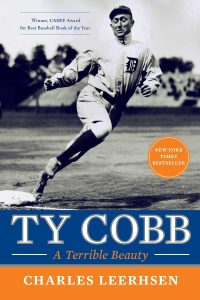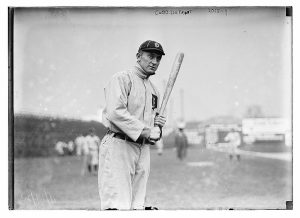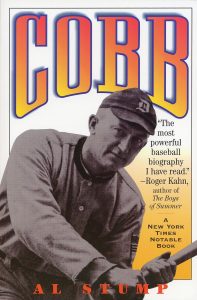For a better future, study the past.
For a better future, study the past.


On the Mount Rushmore of baseball immortality, you will find Ty Cobb, the Georgia Peach. When your career batting numbers include lines such as 4,189 hits, twelve batting titles, a career .366 batting average, and nearly 1,000 stolen bases, immortality is yours. In Ty Cobb: A Terrible Beauty, author Charless Leehrsen takes on the monumental task of rehabilitating Cobb’s tarnished legacy.
Along with his batting prowess however, Cobb has another reputation that is not so glamorous. It is this reputation for fighting, having a short temper, being cheap, claims of his being a dirty player, and racism that former Sports Illustrated editor, Charles Leerhsen attempts to combat in his revisionist biography of Cobb. As reviewer John Williams stated in the New York Times with the books release, “Cobb’s image is not a fixer-upper; it’s a Superfund site.”

Leerhsen has a major bone to pick with Al Stump. Stump, a man with a not so clean reputation himself, was the co-author of Cobb’s autobiography My Life in Baseball, and then more scathing works in True magazine and later the book, Cobb: The Life and Times of the Meanest Man Who Ever Played Baseball, and comes in for repeated criticism, some of it deserved, from Leerhsen. The movie Cobb, based upon Stump’s work is given its share of criticism as well. In his note on sources he states the movie “was no help at all.”
In A Terrible Beauty, we learn of the difficulties Cobb had when breaking into professional baseball. The bullying and hazing of the day are things I hope would never be tolerated in locker rooms today. Some of it bordered on what might be called criminal. Cobb also had to deal with the murder of his father. A murder committed by his mother under mysterious and questionable circumstances.
While Cobb did have many difficulties, these do not allow a biographer to excuse away in any manner Cobb’s actions. He would fight seemingly anyone; from teammates and opponents, to umpires, to team staff, hotel workers, and even fans who catcalled him from the bleachers. Cobb’s admitted actions would probably lead to his banishment from the game today and more lawsuits than his lawyers could attend to.
In trying to bolster Cobb’s reputation, Leerhsen is at times not willing to place blame where it seems to belong, at Cobb’s feet. An example are multiple interactions with Bungy Cummings, an African American groundskeeper, who may have had a liking for alcohol.

In 1906, what looks to have probably started as a harmless interaction between Cummings and Cobb led to a violent fight with teammate Charlie Schmidt. Schmidt claimed to have seen Cobb choking the wife of Schmidt, who was trying to stop Cobb from beating her husband. Leerhsen seems to shake off the episode calling Cummings a drunk. Cobb is forgiven because “It’s worth noting I think [Leerhsen is the I] that he [Cobb] didn’t claim that beating up Cummings and his wife was permissible because there were Negroes who had become too familiar or aggressive (as is sometimes alleged or suggested); what he said, rather, was that he did not beat them up.” This is a claim that seems most improbable. Schmidt is condemned as a man who had fought with Cobb on at least two prior occasions, thus seemingly making him in the wrong by default.
Cobb is deemed to have not been racist for his praise of stars such as Willie Mays. In 1952, regarding Black players in Major League Baseball, Cobb stated, “The Negro should be accepted and not grudgingly but wholeheartedly.” Easy for him to have said twenty-four years into retirement and five years after Jackie Robinson broke the color barrier with the Brooklyn Dodgers. Would a Georgia born and bred Cobb have made such a comment during his playing days?
So, what do we make of Leerhsen’s book? Well, first, I have several editorial complaints that should in no way reflect upon Leerhsen, his research, or the text of this book. First is the lack of a formal bibliography. This is a massive oversight on the part of the publisher. The two page “Note on Sources” that is included is unacceptable. What this “Note” is, is two long unusable paragraphs listing secondary sources. The first paragraph includes works on Cobb (with further bashing of Stump of course.) The second is “Other books I consulted,” a listing of authors and book titles in no conceivable order.
My second issue is what pass for endnotes. Rather than have standard endnotes, what readers are presented with is each chapter receiving a single paragraph of text with page numbers and a very brief comment where material came from. If this material is not included in the “Note on Sources” you are left even further mystified. These paragraphs are difficult and not user friendly, nor are they endnotes. I get not having footnotes, though those are most convenient for readers, and I am happy enough to at least have traditional endnotes. This type of notation should be avoided by all publishers.
After reading Leerhsen what am I left with? First, I am left with the nagging feeling I should have read all of Stump’s works prior. Because A Terrible Beauty is so focused on countering much of what has been written about Cobb, a grasp of that literature would have helped.
Secondly, it seems clear that the author has done plenty of research. While a majority seems to come from newspapers, which often have their own slant, Leerhsen is able to combat much of the reputation Cobb has been given (I hesitate to say earned after reading this book.) I would use the reputation for having been a dirty player as an example here. Instances of Cobb being involved in a “spiking” seem to have been rare. Players of the day do not seem to have universally considered him a dirty player. Did you want to have Cobb barreling down on you while stealing a base or stretching a hit? Probably not; does it appear he went out of his way to injure opposing players, no.
I might like to have seen a bit about Cobb’s legacy, especially in the Royston, GA area. Cobb’s burial location is discussed. This is a must see if you are travelling through town.
At the end of the day, who is the real Tyrus Raymond Cobb? Is it the violent, racist, possibly alcoholic of Al Stump; or the more moderate, misunderstood, Cobb of Charles Leerhsen? It is probably somewhere in between, but Leerhsen has done a commendable job in righting some of the past wrongs we have assumed true of Ty Cobb.
You may find all of Charles Leerhsen’s books using THIS LINK.


Baseball America Magazine Subscription – $86.99
from: Magazine Values